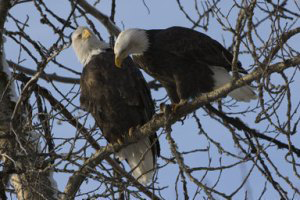Haliaeetus leucocephalus

In the late 1950s, as few as 400 pairs of bald eagles remained in the lower 48 states. Banning of the insecticide DDT, control of illegal shooting, and improved habitat protection have allowed a dramatic recovery. By 1997, the population had grown to more than 5,000 pairs.
Photo Credit: Gerald and Buff Corsi
Haliaeetus leucocephalus
Common Name: bald eagle
Animal Guild: Bird
Class > Order > Family: Aves > Accipitriformes > Accipitridae
ITIS information for
bald eagle (ITIS TSN: 175420 )